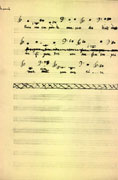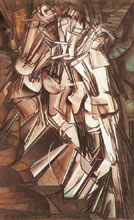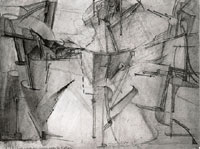Rites of Passage: t / here
| click
to enlarge |
| |
|
Figure
8
|
|
Paul
Cézanne,
Bibémus Quarry, c. 1895,
Museum Folkwang, Essen
|
| |
|
Figure
9
|
|
Marcel
Duchamp, The Bride Stripped Bare by Her Bachelors, Even
[the Large Glass], 1915-23
|
Contrary to de Duve's
claim of the somehow epiphanic significance of Kandinsky and "Secession"--to
which Duchamp was introduced during his 1912 Munich sojourn(18)--even
in Germany, the artist still speaks the lingua franca, not of Kandinsky
and non-objective art, but rather of Cézanne and Cubism (Fig.
8). The Berlin "Secession", he writes to his brother
Jacques Villon, "finally allowed me to see how young French painting
was looking abroad... I was really pleased to find they have Cubism
here, it was so long since I'd seen any. And that certainly played a
part in my having a soft spot for Berlin".(19)
Indeed, in their analogous obsession with the problem of the background,
Duchamp spends the better part of a lifetime pursuing both the Cubists,
and especially the Master of Aix. As he explains to Francis Roberts:
| The
main point is the subject, the figure. It needs no reference.
It is not in relation. All that background on the canvas that
had to be thought about, tactile space like wallpaper, all that
garbage, I wanted to sweep it away... The question of painting
in background is degrading for the painter. The thing you want
to express is not in that background.(20)
|
Of course, the greatest
testament to Duchamp's efforts in this regard is his largely lacunary
Large Glass (1915-23) (Fig. 9). Yet because
the "ground" can never be eliminated, not even by the changeable
view to the other side of the Large Glass, for Duchamp, rather, it was at first a question of how
necessarily to oppose figure to ground, yet otherwise to elide them: in
other words, a formal-as-conceptual question of Cézannian / Cubist "passage".(21)
Notwithstanding Duchamp's
1910 portraits of his father ensconced in an armchair
(Fig. 10), or of his brothers playing chess at an off-miter
card table (Fig. 11), it is not in these
superficially Cézannesque treatments, but rather in such early conceptual
experiments as Avoir l'apprenti dans le soleil [To Have the Apprentice in the Sun] (1914) (Fig.
12) that Duchamp's obsession with the background first comes
to the fore. In this drawing of a bicyclist racing uphill, yet executed
on sheet-music paper, the generative idea is straightforwardly revealed
by the title:
|
avoir
l'apprenti dans le soleil = à voir: l'empreinte qui dans le
sol est
given to sight: the imprint which is in the ground
|
|
click
on images to enlarge |
|
|
|
|
Figure
10
|
Figure
11 |
Figure
12
|
|
Marcel
Duchamp, Portrait of the Artist's Father, 1910
|
Marcel
Duchamp, The Chess Game, 1910
|
Marcel
Duchamp, Avoir l'apprenti dans le soleil
[To Have the Apprentice in the Sun], 1914
|
|
click
to enlarge
|
|
|
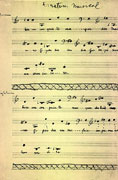 |
|
Figure
13
|
|
Marcel
Ducahmp, Musical Erratum, 1913
|
In Apprentice,
then, although figuration is inherently opposed to the space of musical
notation, nevertheless, the ascending figure of the bicyclist is, at
once, conceptually assimilated to the ascent of the musical scale itself.
For "sol" refers not only to the title sun ["soleil"]
of the drawing--the very precondition of what is given to sight--but
also to the rising ground ["sol"] which the bicyclist ascends,
exactly as the musical scale does also ["sol" = key of G(22)].
In the relationship of its imprint ["empreinte"] to its sheet-music
paper as ground ["sol"], Apprentice in fact revisits
another work of just the prior year, Musical Erratum (1913) (Fig. 13), which
Duchamp scores for three voices, and whose lyrics he exactly appropriates
from a dictionary definition of imprint ["imprimer"].(23)
In this "musical mistake", both the aleatory lyrics themselves,
as well as the equal value of the notes, and their arbitrary order and
range, all participate in the artist's contemporary experiments with
objective chance. Most telling of all, however, are the respective relationships
of the "imprints", or "figures", in Musical
Erratum and Apprentice to their otherwise identical "ground". However unconventional
the lyrics and notes in Musical Erratum, nevertheless, their relationship as musical notation to
their sheet-music paper as ground is entirely conventional. In Apprentice,
by contrast, that relationship--analogizing the ascent of the bicyclist
to that of the musical scale and, therefore, the figure to the ground--has
been entirely conceptualized. As Duchamp explains, "before the
Nude my paintings were visual. After that they were ideatic":(24)
not only in how they convey the "passage" from figure to ground,
however, but also in how they figure the ascent of a bicyclist, like
the descent of a nude, and movement more generally.
| click
to enlarge |
|
|
 |
|
Figure
14
|
Figure
15
|
|
Marcel
Ducahmp, Nude Descending a Staircase, No. 2, 1912
|
Marcel
Ducahmp, Nude Descending a Staircase, No. 1, 1911
|
Indeed, the difference
between the second version of Duchamp's Nude Descending A Staircase
(1912) (Fig. 14) and the first version (1911)
(Fig. 15) is exactly this: the sense of depth, evidenced
by the inward-turning spiral staircase, which the second version specifically
de-emphasizes, and instead replaces with a more conventionally "chronophotographic"
foreground-as-frieze, inspired by Duchamp's interest in the time-lapse
imagery of such photographic pioneers as Etienne-Jules Marey (DDS
170-1; WMD 124).(25)
Yet rather than developing in and through space--conceived in both the
first and the second Nude as an analogously chronophotographic process of successively doubling
the figure--both Passage and Bride are irreducibly whole: constituted of jigsaw-like
elements which are unrepeated and, as such, cannot depict the sort of
spatio-temporal trajectory whose "there", as in either Nude,
is but the displaced double of its "here". Rather, the psycho-sexual
trajectory, or Passage,(26)
from Virgin to Bride, Duchamp instead figures as the forked
rods terminating in semicircles which, at the center of the second Nude,
Passage and Bride, variously exemplify "Le Pendu Femelle"
(Fig. 7(b)-(d)); together with the chronophotographic cues
of Morse Code-like dots and dashes which, similarly inspired by Marey's
time-lapse imagery, in both the second Nude and Passage, Duchamp specifically localizes about "Le Pendu Femelle":
as a series of inscribed arcs in the former; an extremely irregular polygon
in the latter. For "Le Pendu Femelle" is exactly what we should
expect to find in a state of chronophotographic flux as our Virgin
first transits to Bride, as evidenced by the presence of these cues in her Kama Sutra-like
Passage; no longer to be in a state of flux once our Virgin
has definitively arrived there, as evidenced by the absence of these cues,
now, as Bride; and, in any event, invariably to swing, "pendu"(lum)-like,
as our nude bridegroom descends the staircase, as evidenced by the presence
of these cues, first of all, in the second Nude. By contrast,
all reference to "Le Pendu Femelle" is, appropriately, entirely
absent from either version of Duchamp's eternally nubile Virgin.
|
click
to enlarge
|
|
|
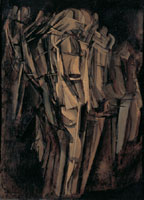 |
|
Figure
16
|
Figure
17
|
|
Marcel
Ducahmp, Nude Descending a Staircase, No. 3, 1916
|
Marcel
Ducahmp, Sad Young Man on a Train, 1911
|
The male-ish gender
of the second Nude, whose title is admittedly neutral on this
score,(27)
is further confirmed by Duchamp's inscription of the third Nude
(1916) (Fig. 16) as the son ["fils"],
presumably, of the second: "Marcel Duchamp [Fils] / 1912-1916",
as the third Nude reveals at recto. Doubtless, "daughter"
would have better served the same filial purpose, were not the second
Nude male; the third Nude a replica of the second; and
both, in this sense, a reprise of another nude young man, from just
the month before the second Nude: Duchamp's Sad Young Man
on a Train (1911) (Fig. 17). Sad
Young Man is a painting of "two parallel movements corresponding
to each other" which, Duchamp elaborates, are those of the train
and of the sad young man passing through its corridor.28)
However, the artist also provides us with two further and frankly anomalous
details: the nude young man is a self-portrait--"Marcel Duchamp
/ nu (esquisse) / Jeune homme triste dans un train...", as he inscribes
the picture at verso--in which he is smoking a pipe.(29)
An entire series of only barely symbolic, yet closely related "parallel
movements" thus emerges, according to which everything rather starts
to resemble the phallus: from the erect young man penetrating the train's
"corridor"; to the train, itself, surely entering the tunnel
of his symbolic; where the pipe he smokes is no longer one--for, "faire
une pipe" is
not to make
a pipe, as Magritte's picture famously disavows (Fig.
18), but rather "to give a blow job". Indeed, the
"parallel movements" of Sad Young Man and, separated by only a month, the second Nude are
entirely comparable: the nude young man, who at first penetrates a venerably
Freudian corridor, in turn, descends an equally venerable staircase:(30)
exactly the psycho-sexual Passage which the title work nominally regenders. No differently, the swing
of his "pipe" in Sad Young Man, at first replaced by that of his "pendu"(lum) in
the second Nude, Duchamp analogously regenders as "Le Pendu
Femelle" in both Passage and Bride. Rather, the salient difference between Sad
Young Man and the second Nude is the use of chronophotographic
cues in the latter -- to supplement the similarly chronophotographic
process of successively doubling the figure in both works--in a way
which specifically isolates and identifies "Le Pendu Femelle".
The source of these chronophotographic cues--in the time-lapse imagery
of the foils Marey's fencers wield -- exactly re-emphasizes the phallic
aspect of "Le Pendu Femelle" by transforming Marey's fencers'
foils into the "phallic barbs" which, as John Golding observes,
everywhere proliferate throughout Duchamp's first stab at The Bride
Stripped Bare By The Bachelors (1912) (Fig. 19).(31)
>>Next
| click
to enlarge |
| |
|
| Figure
18 |
Figure
19 |
| René
Magritte, The Treachery of Images, 1929 |
Marcel
Duchamp, The Bride Stripped Bare By The Bachelors, 1912 |
page 1 2 3 4
5 6
Notes
 17.
Dawn Ades, Neil Cox, David Hopkins, Marcel Duchamp (N.Y.: Thames
and Hudson, 1999) 55. 17.
Dawn Ades, Neil Cox, David Hopkins, Marcel Duchamp (N.Y.: Thames
and Hudson, 1999) 55.
 18.
De Duve, Pictorial Nominalism, pp. 96-118. See also Anne d'Harnoncourt,
Kynaston McShine, eds., Marcel Duchamp (N.Y.: Museum of Modern
Art, 1973) 263, where Duchamp refers to Munich as "the scene
of my complete liberation", albeit without explanation. 18.
De Duve, Pictorial Nominalism, pp. 96-118. See also Anne d'Harnoncourt,
Kynaston McShine, eds., Marcel Duchamp (N.Y.: Museum of Modern
Art, 1973) 263, where Duchamp refers to Munich as "the scene
of my complete liberation", albeit without explanation.
 19.
Marcel Duchamp, Affectionately, Marcel: The Selected Correspondence
of Marcel Duchamp, ed. Francis Naumann, Hector Obalk, trans. Jill
Taylor (Ghent: Ludion Press, 2000) 26. But it's also unclear how Duchamp's
defining gestures -- not only the famous fracas caused by the second
Nude at the Armory Show, but also the scandalous submission
of Fountain to the New York Independents exhibition -- betrays
even the slightest influence of German "Secession", rather
than the specifically discontinuous model of Parisian avant-garde
rejection, to which de Duve opposes it. 19.
Marcel Duchamp, Affectionately, Marcel: The Selected Correspondence
of Marcel Duchamp, ed. Francis Naumann, Hector Obalk, trans. Jill
Taylor (Ghent: Ludion Press, 2000) 26. But it's also unclear how Duchamp's
defining gestures -- not only the famous fracas caused by the second
Nude at the Armory Show, but also the scandalous submission
of Fountain to the New York Independents exhibition -- betrays
even the slightest influence of German "Secession", rather
than the specifically discontinuous model of Parisian avant-garde
rejection, to which de Duve opposes it.
 20.
Roberts,
"Interview with Marcel Duchamp", p. 46. See also Duchamp, Cabanne, Dialogues
with Marcel Duchamp, p. 18. 20.
Roberts,
"Interview with Marcel Duchamp", p. 46. See also Duchamp, Cabanne, Dialogues
with Marcel Duchamp, p. 18.
 21.
See Ades, Cox, Hopkins, Marcel Duchamp, p. 55. Cézanne, therefore,
is not only the "retinal" painter whom Duchamp consistently
excoriates, but also the "father" of Modernist art (in de
Duve's sense) whom Duchamp, by instead conceptualizing the
"retinal" figure-ground problem, both overthrows and, at
once, becomes. 21.
See Ades, Cox, Hopkins, Marcel Duchamp, p. 55. Cézanne, therefore,
is not only the "retinal" painter whom Duchamp consistently
excoriates, but also the "father" of Modernist art (in de
Duve's sense) whom Duchamp, by instead conceptualizing the
"retinal" figure-ground problem, both overthrows and, at
once, becomes.
 22.
Carol James, "Duchamp's Silent Noise / Music for the Deaf",
in Marcel Duchamp: Artist of the Century, ed. Rudolf Kuenzli,
Francis Naumann (Cambridge, Mass.: M.I.T., 1990) 113. 22.
Carol James, "Duchamp's Silent Noise / Music for the Deaf",
in Marcel Duchamp: Artist of the Century, ed. Rudolf Kuenzli,
Francis Naumann (Cambridge, Mass.: M.I.T., 1990) 113.
 23.
Duchamp's lyrical definition reads: "Faire une
empreinte; marquer des traits; une figure sur une surface; imprimer un sceau
sur cire" [Make an imprint; mark with lines; a figure on a surface;
impress a seal in wax] (DDS 52-53; WMD 34). 23.
Duchamp's lyrical definition reads: "Faire une
empreinte; marquer des traits; une figure sur une surface; imprimer un sceau
sur cire" [Make an imprint; mark with lines; a figure on a surface;
impress a seal in wax] (DDS 52-53; WMD 34).
 24.
Roberts,
"Interview with Marcel Duchamp", p. 46. 24.
Roberts,
"Interview with Marcel Duchamp", p. 46.
 25.
E.g. Duchamp, Cabanne, Dialogues with Marcel Duchamp, p. 34;
Roberts, "Interview with Marcel Duchamp", p. 46; Katherine
Kuh, The Artist's Voice: Talks with Seventeen Artists (N.Y.:
Harper and Row, 1962) 83. 25.
E.g. Duchamp, Cabanne, Dialogues with Marcel Duchamp, p. 34;
Roberts, "Interview with Marcel Duchamp", p. 46; Katherine
Kuh, The Artist's Voice: Talks with Seventeen Artists (N.Y.:
Harper and Row, 1962) 83.
 26.
On Passage as instantiating a sort of spatio-temporal collapse,
see Jonathan Crary, "Marcel Duchamp's 'The Passage from Virgin
to Bride'", Arts Magazine, vol. 51, no. 5 (Jan. 1977):
96-99. 26.
On Passage as instantiating a sort of spatio-temporal collapse,
see Jonathan Crary, "Marcel Duchamp's 'The Passage from Virgin
to Bride'", Arts Magazine, vol. 51, no. 5 (Jan. 1977):
96-99.
 27.
In a 1916 interview, Duchamp circumvents the question of the second
Nude's gender as follows: "'Is it a woman?' this young
but very world-weary Frenchman repeated after me... 'No. Is it a man?
No... The Nude descending a staircase is an abstraction of movement'".
Dawn Ades, "Duchamp's Masquerades", in The Portrait in
Photography, ed. Graham Clarke (London: Reaktion Books, 1992),
pp. 102-3. For a balanced reading of the second Nude's possible
gender(s), see Ades, Cox, Hopkins, Marcel Duchamp, pp. 48-51. 27.
In a 1916 interview, Duchamp circumvents the question of the second
Nude's gender as follows: "'Is it a woman?' this young
but very world-weary Frenchman repeated after me... 'No. Is it a man?
No... The Nude descending a staircase is an abstraction of movement'".
Dawn Ades, "Duchamp's Masquerades", in The Portrait in
Photography, ed. Graham Clarke (London: Reaktion Books, 1992),
pp. 102-3. For a balanced reading of the second Nude's possible
gender(s), see Ades, Cox, Hopkins, Marcel Duchamp, pp. 48-51.
 28.
Duchamp, Cabanne, Dialogues
with Marcel Duchamp, p. 29. 28.
Duchamp, Cabanne, Dialogues
with Marcel Duchamp, p. 29.
 29.
Duchamp, Cabanne, Dialogues with Marcel Duchamp,
p. 33. 29.
Duchamp, Cabanne, Dialogues with Marcel Duchamp,
p. 33.
 30.
See Marcel Jean, The History of Surrealist Painting, trans.
Simon Taylor (London: Weidenfeld and Nicolson, 1960) 34. 30.
See Marcel Jean, The History of Surrealist Painting, trans.
Simon Taylor (London: Weidenfeld and Nicolson, 1960) 34.
 31.
See John Golding, Marcel Duchamp: The Bride Stripped Bare By Her
Bachelors, Even (N.Y.: Viking Press, 1973) 41. Duchamp's title
Disk Inscribed with Pun (1926) makes the connection between
foil and phallus explicit: "Avez vous déjà mis la moëlle de l'épée
dans le poêle de l'aimée?" [Haven't you already put the stem
of the foil in the stove of the goil?] (cf. DDS 153; WMD
106). 31.
See John Golding, Marcel Duchamp: The Bride Stripped Bare By Her
Bachelors, Even (N.Y.: Viking Press, 1973) 41. Duchamp's title
Disk Inscribed with Pun (1926) makes the connection between
foil and phallus explicit: "Avez vous déjà mis la moëlle de l'épée
dans le poêle de l'aimée?" [Haven't you already put the stem
of the foil in the stove of the goil?] (cf. DDS 153; WMD
106).
Figs.
9-17, 19
©2003 Succession Marcel Duchamp, ARS, N.Y./ADAGP, Paris. All
rights reserved.
|





